Fall 2022 Tree Species Availability Free Tree Giveaway
Take home your own free tree!
Blue Water Baltimore is partnering with the Baltimore County Department of Environmental Protection and Sustainability, TreeBaltimore and Stillmeadow Community Fellowship to offer residents a variety of native tree species for FREE! From small flowering and fruiting trees to large canopy trees, each one makes a difference in our city. Trees cool and clean our air, absorb stormwater, increase biodiversity, and beautify our neighborhoods.
How it works
- Free trees are for residents of Baltimore County or Baltimore City only. By accepting a tree, you are agreeing to plant it on your property/with permission from property owner within 4 weeks of the giveaway date (by Dec 3rd, 2022).
- Trees will be available via pre-registration beginning October 22nd. We will have plenty of extras for walk-ups during the event. Pre-registered trees MUST be picked up between 10am-12pm on November 5th, 2022 at Stillmeadow Community Fellowship. Any unclaimed trees will be made available for walk-ups after 12pm.
- Free trees are for planting in your property in the front/back yard only. Not in a pot or container. Not in a street tree bed. (If you are a resident of Baltimore City and would like to request a new STREET tree, use this form instead.)
- There is a limit of 3 pre-registered trees per household. Remember, understory trees are limited to only ONE per species per household. All other trees allow up to 2-3.
- All trees are first-come, first-serve, while supplies last.
- Note: This website is intended to provide general information only. Always seek the advice of a health professional before eating any plant matter. Information provided is not designed to diagnose, prescribe, or treat any illness, or injury. Always consult a health care professional or medical doctor when suffering from any health ailment, disease, illness, or injury, or before attempting any traditional or folk remedies. As with any natural product, they can be toxic if misused.
The pre-registration form to sign up for a free tree will be posted on Monday, October 24th on the event page.
We need your help! Get involved. We are looking for volunteers to help us give out the trees to residents on Saturday, November 5th. Sign up for a shift today!
Right tree, Right place
How do I pick the right tree for my yard?
It is essential that you to carefully select the tree(s) species that make sense for your unique space and needs. Before placing your tree order, take a moment to go outside and look at your yard. Consider any overhead power lines, low areas where rainwater collects, nearby pedestrian right of ways, etc that might affect your choice. Review the available species listed below and plan for the expected height and spread, lifespan, and sunlight and soi requirements. Many of these species will live for a few decades and up to a couple of centuries, so choose wisely. Check out this Arbor Day guide for more assistance.
This fall, we will have: American hornbeam, American plum, shadblow serviceberry, flowering dogwood, pawpaw, American holly, American persimmon, American beech, Eastern red cedar, bald cypress, southern red oak, white oak and bur oak.
For planting tips & tricks, please check out our How-To-Plant blog.
American hornbeam – Carpinus caroliniana
LIMIT ONE PER ORDER
Height: 20-35 feet | Spread: 20-35 feet | Light: partial shade-full shade | Moisture: well-drained, moist
American hornbeam is a slow-growing, medium-sized tree with distinctive muscle-like bark and attractive red-orange fall foliage. It is naturally found growing near the forest floor and therefore prefers partial to full shade. It flourishes along stream banks and bottomlands and tolerates periodic flooding, though it shows remarkable adaptability to drier, sunnier sites. Other common names include blue beech, water beech, musclewood and ironwood. As the common name suggests, the extremely hard wood of this tree was once used to make bowls, tool handles and ox yokes. American hornbeam is the larval host for several native butterflies including the Eastern Tiger Swallowtail as well as an important nesting site for the ruby-throated hummingbird.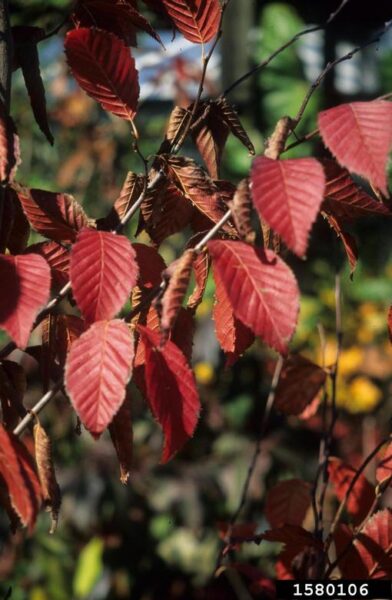
Foliage, Photo by John Ruter
American plum – Prunus americana
LIMIT TWO PER ORDER
Height: 15-25 feet | Spread: 15-25 feet | Light: full sun-partial shade | Moisture: dry to medium, well-drained
American plum is a fast-growing, popular residential landscape tree with fragrant, white flowers in early spring. Late-summer fruits are sweet and juicy, making excellent jams, jellies, preserves and pies. The plums can also be halved, then pitted and dried like prunes, spread in a thin sheet and dried as fruit leather. Fall leaf color ranges from electric red to pale yellow. Regular removal of suckers, or branches growing from the base of the tree, is sometimes necessary to prevent unwanted spread. Trees provide valuable nesting cover and are a host to many butterflies. They tolerate drought, dry soil, and black walnut juglone (allelopathic chemicals that inhibit the growth of other plants).
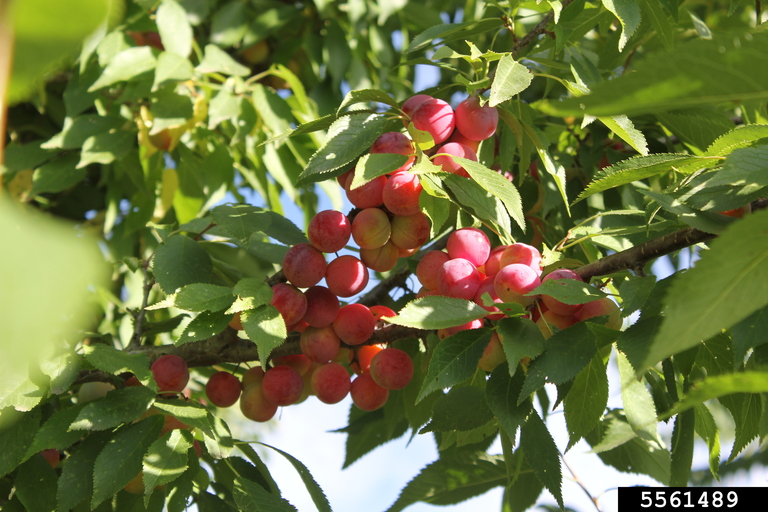
Fruit(s), Photo by Whitney Cranshaw
Shadblow serviceberry – Amelanchier canadensis
LIMIT ONE PER ORDER
Height: 15-30 feet | Spread: 10-20 feet | Light: full sun-full shade | Moisture: moist-slightly dry
Allegheny serviceberry, also called Juneberry, Shadbush, and Saskatoon, is a small, often multi-trunked understory tree or tall shrub. It features showy white flowers in clusters in early spring before the leaves emerge. These blooms give way to delicious purple-red edible berries in June that resemble blueberries in size, color and taste. Berries can be eaten raw or used in jams and pies! If you don’t eat them, the birds certainly will. Serviceberries finish off the year with attractive yellow-orange leaf color. They prefer moist, acidic, well-drained loams and will tolerate a range of soil types but not drought. Serviceberries are medium to fast-growing but fairly short-lived tree. Note: serviceberries are susceptible to cedar apple rust (passed along by both cedar and apple trees), which does not generally harm the tree but renders the berries inedible.
Photo by Zoe Gensheimer
Flowering dogwood – Cornus florida
LIMIT ONE PER ORDER
Height: 15-30 feet | Spread: 20-30 feet | Light: full shade-part shade | Moisture: moist, well-drained
Flowering dogwood is a shade-loving tree commonly found growing as an understory species near the forest floor. It is not tolerant of stresses such as heat, drought, pollution, or road salt. The powdered bark of the trunk was reportedly used in toothpaste and black ink, and as an aspirin-like substance. Song and game birds eat the berries. Easily susceptible to powdery mildew.
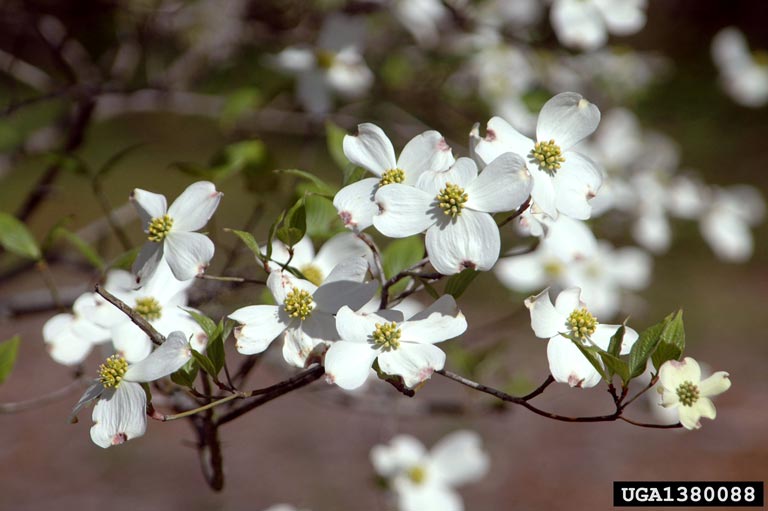
Flower(s), Photo by Chris Evans
Pawpaw – Asimina triloba
LIMIT TWO PER ORDER
Height: 15-30 feet | Spread: 15-25 feet | Light: full sun-part shade | Moisture: medium-wet
Known as the ‘forgotten fruit,” pawpaw it is the largest edible native fruit found in the US, and the only temperate member of a tropical family. Harvest pawpaws in early fall when yellowish-green fruit is just-soft and falling to the ground. Fruits are reminiscent of a mango, with a creamy inside that can be eaten raw or cooked. Purple, six-petaled flowers appear before leaf emergence. This is a good understory tree often found on the forest floor. No serious disease or insect problems. Fruit can create a mess on sidewalks and patios, but this can be minimized by planting only one tree; pawpaws seldom set much fruit without cross pollination.
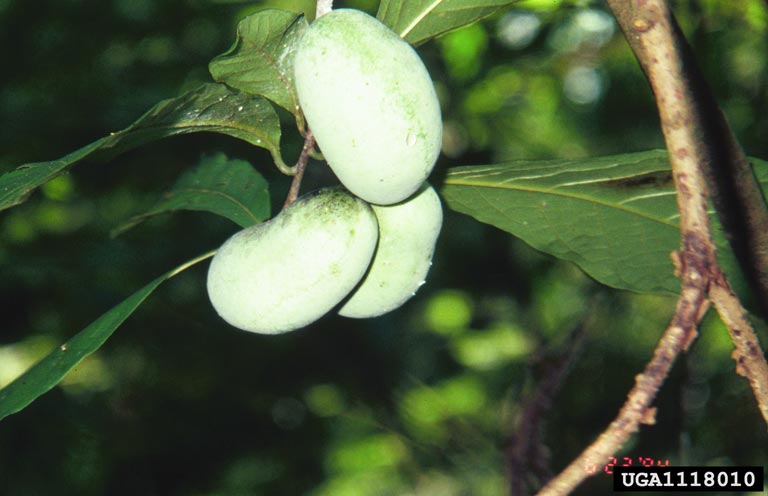
Fruit(s), Photo by Brian Lockhart
American holly – Ilex opaca
LIMIT TWO PER ORDER
Height: 30-50 feet | Spread: 15-25 feet | Light: full sun-part shade | Moisture: dry-moist
American holly is a slow-growing evergreen tree that adds year-round beauty to landscaping. Hollies make great privacy screens and are often planted in groups. If you plant American holly for the bright red berries, you will need to plant more than one to make sure you have both male and female plants. American holly provides important wildlife services. Many species of birds and mammals eat the bitter berries, but the fruits are poisonous to humans. The tree also forms a thick canopy which offers protection for birds from predators and storms. The flowers are pollinated by insects including bees, wasps, ants and night-flying moths. American holly is the larval plant for Henry’s Elfin butterfly. This is the holly whose berry-laden boughs are typically collected at Christmas time each year for ornamentation (“decking the halls” as it were).
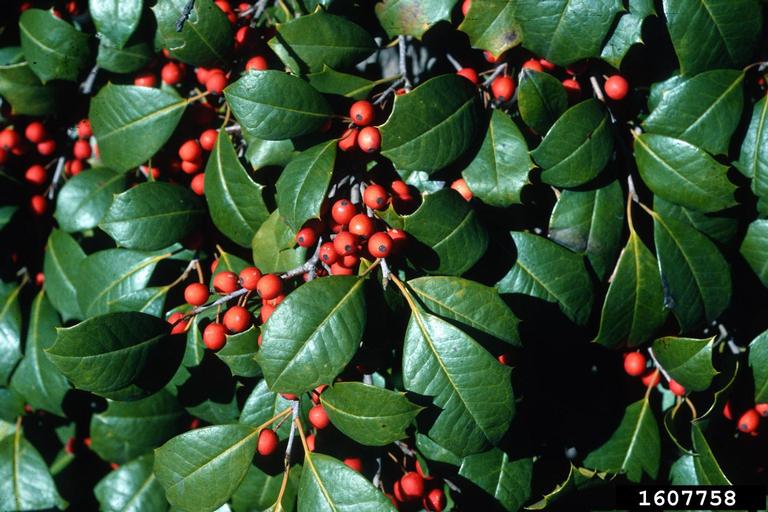
Fruit(s), Photo by John Ruter
American persimmon – Diospyros virginiana
LIMIT TWO PER ORDER
Height: 40-60 feet | Spread: 25-35 feet | Light: full sun- partial shade | Moisture: dry-medium, well-draining
The American, or common, persimmon produces a sweet, edible fruit best enjoyed after it softens after the first frost in late autumn. When ripe, the sweet fruit of somewhat recalls the flavor of dates. Immature fruit contains tannin and are strongly astringent. Persimmons are consumed fresh and are used to make puddings, cakes, and beverages. Because the persimmon is normally dioecious (male and female flowers appear on separate trees), the best way to ensure fruit production is to plant multiple trees. Mature trees are easily identifiable by thick, dark-gray bark that is deeply furrowed and broken into scaly, squarish blocks.

Photo by Zoe Gensheimer
American beech – Fagus grandiflora
LIMIT ONE PER ORDER
Height: 50-80 feet | Spread: 40-80 feet | Light: full sun – partial shade | Moisture: moist, well-drained
American Beech is a large, spreading shade tree. The tree bears edible beechnuts, which are among the most important food source for a variety of wildlife, especially squirrels, raccoons, bears, other mammals, and game birds. They are shade tolerant and long-lived. Not suitable for small areas. The leaves turn golden bronze in fall and often remain on the tree through the winter (marcescence). Unlike most trees, beeches retain smooth bark in age. The trunks are favorites for carving to preserve initials and dates indefinitely, but please avoid this practice as it damages the tree! Beech are generally deer resistant but intolerant of wet, poorly drained soils. They can be difficult to transplant and do not always grow well in urban settings.
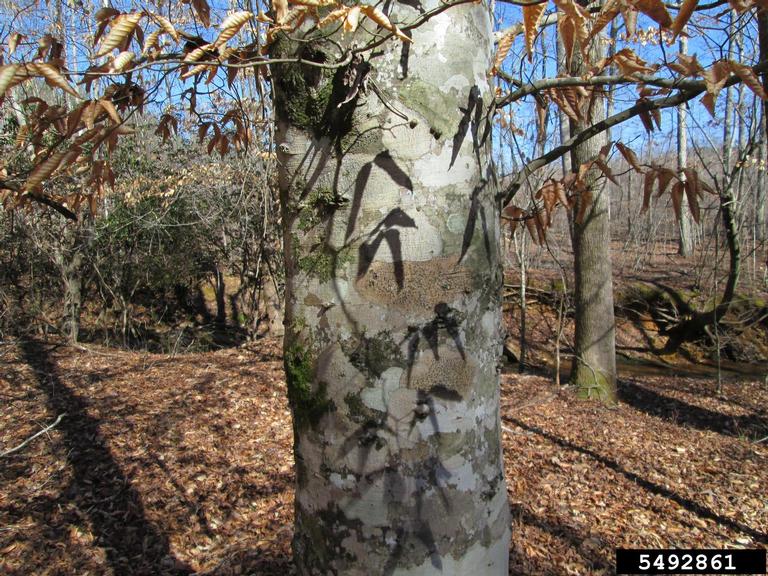
Bark, Photo by David Stephens
Eastern red cedar – Juniperus virginiana
LIMIT TWO PER ORDER
Height: 30-65 feet | Spread: 8-25 feet | Light: full sun | Moisture: dry-moist
The eastern red cedar has a compact, pyramid shape is excellent for windbreaks and screens. Fragrant, evergreen foliage provides nesting and roosting cover for native birds. They love its small, rounded fruit that is gray or bluish-green in color . This fruit, which appears only on female trees, resembles a berry but it is actually a cone made of fused scales. Red cedar can be injurious to apple orchards because it is an alternate host for cedar-apple rust, a fungal disease. Avoid planting near serviceberries. Fun facts: The wood was a staple of the pencil industry for over a century until supplies became exhausted and the industry switched to more plentiful western cedars. This cedar is an ancient tree and fossil evidence indicates it once covered large portions of the continent.

Photo by Zoe Gensheimer
Bald cypress – Taxodium distichum
LIMIT TWO PER ORDER
Height: 50-70 feet | Spread: 20-45 feet | Light: full sun- partial shade | Moisture: medium-wet
Bald cypress is a majestic long-lived, pyramidal conifer (cone-bearing tree) with soft, ferny foliage that enhances many landscapes. Although they resemble a needled evergreen (same family as redwoods), they are deciduous, which means that their feathery leaves turn copper-colored and fall to the ground in the winter. (The tree becomes “bald” and leafless as the common name suggests!) Bald cypress prefer “wet feet” or moist areas. In the deep South, large stands are a familiar sight growing directly in swampy water, with their branches heavily draped with Spanish moss. Bald cypresses often develop distinctive, knobby root growths (“knees”) which protrude above the water surface around the tree. In cultivation, however, they also grow well in drier, upland soils or as street trees. Trunks feature an attractive, exfoliating bark and are buttressed (flared or fluted) at the base.

Fruit(s), Photo by T. Davis Sydnor
White oak – Quercus alba
LIMIT THREE PER ORDER
Height: 60-90 feet | Spread: 60-80 feet | Light: full sun | Moisture: moist
The white oak is a large, handsome tree named for its whitish bark and grey twigs. It is slow growing and long-lived with glossy, bright green leaves. Do not plant in shade, areas of poor drainage, or alkaline soil. White oaks are the state tree of Maryland as well as Connecticut and Illinois. The largest known white oak specimen had a circumference of 32 feet and grew in the Wye Oak State Park, Talbot County, Maryland. In general, oaks are a keystone species, meaning that entire ecosystems depend on them for survival. They can live for centuries, providing food and habitat for hundreds of species of wildlife, and cleaning the air for future generations! If you have the space, choose this tree! Leave a legacy of clean air and water.

Foliage, Photo by Paul Wray
Southern red oak – Quercus falcata
LIMIT THREE PER ORDER
Height: 60-80 feet | Spread: 40-50 feet | Light: full sun | Moisture: dry-moist
This is an ornamentally attractive oak with a straight trunk and an open rounded crown. It is best grown in acidic, dry to medium, well-drained loams in full sun but will tolerate some shade. It is also tolerant of poor and sandy soils as well as drought. The Southern red oak is moderately resistant to damage by deer. The leaf easily recognizable by its elongated, narrow tip (terminal lobe), which often referred to as a “witches’ finger.” A relatively fast-growing oak. This southern species will do well in our region as the climate warms. In general, oaks are a keystone species, meaning that entire ecosystems depend on them for survival. They can live for centuries, providing food and habitat for hundreds of species of wildlife, and cleaning the air for future generations! If you have the space, choose this tree! Leave a legacy of clean air and water.

Foliage, Photo by Chris Evans
Bur oak – Quercus macrocarpa
LIMIT THREE PER ORDER
Height: 40-90 feet | Spread: 50-70 feet | Light: full sun | Moisture: medium-wet
Bur oak is named for its furry, “bur like” acorn caps that cover large, gold-ball sized acorns. It may take up to 35 years this tree to bear a first crop of acorns. It is of the white oak group. The leaves of bur oak also are large, so they are easy to rake. This species is resistant to oak wilt and a number of other problems and is capable of withstanding a ide range of harsh conditions (one of the most drought resistant oaks). Twigs are sometimes ridged with corky wings. The bur oak is the “most western of the eastern oaks”, extending all the way to the foothills of the Rockies! In general, oaks are a keystone species, meaning that entire ecosystems depend on them for survival. They can live for centuries, providing food and habitat for hundreds of species of wildlife, and cleaning the air for future generations! If you have the space, choose this tree! Leave a legacy of clean air and water.

Acorns, Photo by Sean O’Maille



